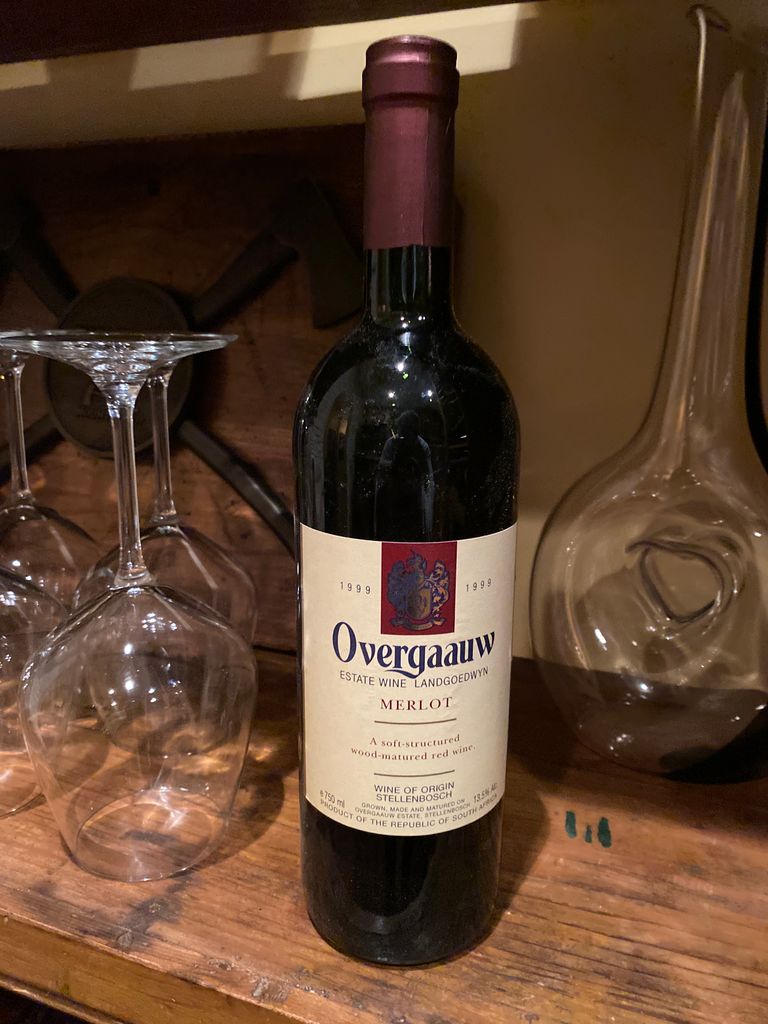
External search
Google (images)
Wine Advocate
Wine Spectator
Burghound
Wine-Searcher
Vintages
2020
2017
2014
2013
2012
2011
2010
2009
2006
2005
2004
2002
2001
2000
1999
1998
1997
1994
1991
1989
Show more
From this producer
Show all wines
All tasting notes
|
| Drinking Windows and Values |
| Drinking window: Drink between 1995 and 1998 (based on 6 user opinions) |
| Community Tasting History |
| Overgaauw Producer website
Overgaauw Estate
A long line of settler blood has created an understated, but solidly red reputation at Overgaauw Estate. Leonie Joubert visited the Van Velden family farm, a Stellenbosch stalwart which was responsible for the country's first Merlot - and its only Sylvaner.
What you see on the Overgaauw winelist may now seem passé - every farm these days has a stock supply of noble varieties and usually a Pinotage on the side. But back in 1982 there wasn't a single Merlot on the market. Van Velden grabbed the bull by the horns and bottled one that year.
"We first planted Merlot in 1975 and decided to bottle it on its own in 1982. Then people said Merlot was a blending wine and shouldn't be on its own… but now it's one of the most popular varieties!" This was followed by the first varietal Touriga Nacional in 1986.
Another legacy is the Sylvaner. This German grape has been bottled here since 1971 and remains the sole Cape example (besides a brief flirtation with it by Nederburg some years back). "WINE magazine did a vertical tasting of 25 Overgaauw Sylvaners - 1971 to 1996 - and the tasters were amazed at how well they had kept. The '73 impressed me the most," says Braam.
"It makes nice wine! It has slight Muscat and Weisser Riesling flavours, but without the terpene character."
There are some upfront drinking wines to accommodate the more impatient palate - like the Pinotage/Cabernet Franc blend. Other innovations in the pipeline?
"Hmmm…," he ponders, "there's no easy answer. All the major (wine producing) countries have something which makes them different and unique. Should we copy them or not? I'm not sure - maybe we should plant quantities of Viognier and Zinfandel and experiment… after all, people once said Merlot was only for blending!"
He is considering Malbec and Sangiovese.
"I won't do a Viognier… although I have been known to change my mind!"
As members of the Cape Winemakers Guild, Van Velden and Joubert have other likeminded people with whom to share their experiments.
Meeting market demand requires judicious vineyard management, something which has developed a life of its own at Overgaauw. "In your lifetime you only have two chances to replant a vineyard - given that a vineyard lasts about 25 years - so you can't afford to mess up!" explained Van Velden of his philosophy to vine cultivation.
It's one that has been in action for the 29 years that he's been running things. When he took over winemaking in 1973, 90% of the farm's vines were white, at a time when there was a global shortage of red wine. By the late '70s he was having soils analysed and had mapped out a replanting programme that, over almost three decades, has become a continually evolving process. One small patch of cover crop, high up on the farm, is all that remains of the vineyards planted by his father. Since then the entire farm has been replanted… and it will continue to be.
"We have replanting plans right up until 2009," he said.. Even then, he knows it won't end there. There will always be new research and new clones to experiment with for the greater client satisfaction.
MerlotMerlot is a dark blue–colored wine grape variety, that is used as both a blending grape and for varietal wines. The name Merlot is thought to be a diminutive of merle, the French name for the blackbird, probably a reference to the color of the grape. Its softness and "fleshiness", combined with its earlier ripening, makes Merlot a popular grape for blending with the sterner, later-ripening Cabernet Sauvignon, which tends to be higher in tannin.South Africa Wines of South AfricaStellenbosch Stellenbosch Wine RoutesStellenboschThe historical town of Stellenbosch boasts a winemaking tradition which stretches back to the end of the 17th-century.
Stellenbosch is the educational and research centre of the winelands. Stellenbosch University is the only one in South Africa with a viticultural and oenological department, and many of the country's most successful winemakers studied there. The Nietvoorbij Institute of Viticulture and Oenology is also in Stellenbosch and this organisation has one of the most modern experimental wineries in the world and, at its experimental farms (situated in several wine growing districts), important research into new varietals, clones and rootstocks is undertaken.
The mountainous terrain, good rainfall, deep well-drained soils and diversity of terroirs make this a sought-after viticultural area. The rapidly increasing number of wine estates includes some of the most famous names in Cape wine. The district, with its mix of historic estates and contemporary wineries, produces excellent examples of almost all the noble grape varieties.
The intensively farmed Stellenbosch district has been divided up into several smaller viticultural pockets including Jonkershoek Valley, Papegaaiberg, Simonsberg-Stellenbosch, Bottelary, Devon Valley and Banghoek. |
|




